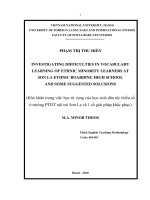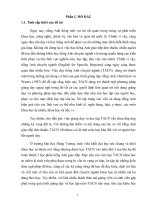Những khó khăn trong việc học kỹ năng nghe của sinh viên năm thứ nhất trường Đại học Hàng hải Việt Nam và một số giải pháp khắc phục
Bạn đang xem bản rút gọn của tài liệu. Xem và tải ngay bản đầy đủ của tài liệu tại đây (1.24 MB, 61 trang )
VIETNAM NATIONAL UNIVERSITY, HANOI
UNIVERSITY OF LANGUAGES AND INTERNATIONAL STUDIES
FACULTY OF POST-GRADUATE STUDIES
LÊ THỊ HỒNG LOAN
DIFFICULTIES IN LEARNING LISTENING SKILLS EXPERIENCED BY
FIRST-YEAR STUDENTS AT VIETNAM MARITIME UNIVERSITY AND
SOME SUGGESTED SOLUTIONS
(NHỮNG KHÓ KHĂN TRONG VIỆC HỌC KỸ NĂNG NGHE CỦA SINH
VIÊN NĂM THỨ NHẤT TRƯỜNG ĐẠI HỌC HÀNG HẢI VIỆT NAM VÀ
MỘT SỐ GIẢI PHÁP KHẮC PHỤC)
M.A. MINOR THESIS
Field: English Teaching Methodology
Code: 60.14.10
HANOI - 2012
VIETNAM NATIONAL UNIVERSITY, HANOI
UNIVERSITY OF LANGUAGES AND INTERNATIONAL STUDIES
FACULTY OF POST-GRADUATE STUDIES
LÊ THỊ HỒNG LOAN
DIFFICULTIES IN LEARNING LISTENING SKILLS EXPERIENCED BY
FIRST-YEAR STUDENTS AT VIETNAM MARITIME UNIVERSITY AND
SOME SUGGESTED SOLUTIONS
(NHỮNG KHÓ KHĂN TRONG VIỆC HỌC KỸ NĂNG NGHE CỦA SINH
VIÊN NĂM THỨ NHẤT TRƯỜNG ĐẠI HỌC HÀNG HẢI VIỆT NAM VÀ
MỘT SỐ GIẢI PHÁP KHẮC PHỤC)
M.A. MINOR THESIS
Field: English Teaching Methodology
Code: 60.14.10.
Supervisor: Phạm Thị Thanh Thủy, M.A.
HANOI - 2012
iv
TABLE OF CONTENTS
Declaration……… ……………………………………………………………………
i
Acknowledgements……………………………………………………………………
ii
Abstract………………………………………………………………………………
iii
Table of contents….…………………………………………………………………
iv
List of charts… ……………….………………………………………………………
ix
CHAPTER ONE: INTRODUCTION
1.1. Statement of the problem and rationale of the study…………………………
1
1.2. Aims of the study……………………………………………………………….
1
1.3. Scope of the study……………………………………………………………
2
1.4. Significance of the study……………………………………………………….
2
1.5. Design of the study……………………………………………………………
2
CHAPTER TWO: LITERATURE REVIEW
2.1. Listening comprehension………………………………………………………….
4
2.2. Component skills of listening……………………………………………………
4
2.3. Potential problems in learning listening…………………………………………
6
2.3.1. Sounds…………………………………………………………………
6
2.3.2. Stress and intonation…………………………………………………….
7
v
2.3.3. Vocabulary………………………………………………………………
8
2.3.4. Speech rate………………………………………………………………
9
2.3.5. Accent……………………………………………………………………
9
2.3.6. Redundancy……………………………………………………………
10
2.3.7. Speech organization……………………………………………………
10
2.3.8. Informal language……………………………………………………….
10
2.3.9. Background knowledge………………………………………………….
11
2.3.10. Fatigue and concentration……………………………….……………
11
2.3.11. Psychological problems…………………………………….…………
11
2.3.12. Number of speakers…………………………………………………….
12
2.3.13. Familiarity of topic……………………………………………………
12
2.3.14. Confidence……………………………………………………………
12
2.3.15. Interest and motivation…………………………………………………
12
2.4. Three stages in teaching listening…………………………………………………
13
2.4.1. Pre-listening……………………………………………………………
13
2.4.2. While-listening…………………………………………………………
13
2.4.3. Post-listening…………………………………………………………….
14
2.5. Previous study on listening difficulties………………………………………….
2.6. Summary………………………………………………………………………….
14
15
vi
CHAPTER THREE: THE STUDY
3.1. The setting of the study…………………………………………………………
16
3.2. Participants………………………………………………………………………
16
3.2.1. Students………………………………………………………………….
16
3.2.2. Teachers………………………………………………………………….
16
3.3. Research methods…………………………………………………………………
17
3.3.1. Data collection instruments……………………………………………
17
3.3.2. Data analysis methods…………………………………………………
17
3.4. Data analysis… ………………………………………………………………….
17
3.4.1. Learners and teachers‟ perceptions of linguistic difficulties in
learning listening……………………………………………………………….
17
3.4.2. Learners and teachers‟ perceptions of listening difficulties
related to the listening text…………………………………………………….
19
3.4.3. Learners and teachers‟ perceptions of listening difficulties
related to the speakers………………………………………………………….
21
3.4.4. Learners and teachers‟ perceptions of listening difficulties
related to the listener…………………………………………………………
23
3.4.5. Learners‟ expectations towards their teachers and teachers‟ opinions
about how they can help their students………………………………………
25
vii
3.5. Summary…………………………………………………………………………
27
CHAPTER FOUR: DISCUSSIONS AND RECOMMENDATIONS
4.1. Difficulties in learning listening encountered by first-year students at
Vietnam Maritime University and possibles sources of these difficulties…………….
28
4.2. Recommendations to help students overcome difficulties in learning
listening………………………………………………………………………………
29
4.2.1. Helping students with vocabulary……………………………
29
4.2.2. Dealing with sounds, stress and intonation……………………………
30
4.2.3. Helping students get familiar with different accents…………
31
4.2.4. Creating expectations……………………………………………………
31
4.2.5. Overcoming psychological problems……………………………………
31
4.2.6. Using visuals…………………………………………………
32
4.2.7. Giving clear instruction………………………………………
33
4.2.8. Utilizing the internet……………………………………………………
33
4.2.9. Using music……………………………………………………………
35
4.2.10. Providing task variety and text variety…………………………………
35
4.2.11. Encouraging self-study…………………………………………………
37
4.3. Summary…………………………………………………………………………
37
CHAPTER FIVE: CONCLUSION
viii
5.1. Conclusions……… ……………………………………………………………
38
5.2. Limitations and suggestions for further study…………………………………….
39
REFERENCES……………………………………………………………………….
40
APPENDICES………………………………………………………………………
I
ix
LIST OF CHARTS
Chart 1: Learners‟ perceptions of their linguistic difficulties in learning listening
Chart 2: Teachers‟ perceptions of students‟ linguistic difficulties in learning listening
Chart 3: Learners‟ perceptions of their listening difficulties related to the listening text.
Chart 4: Teachers‟ perceptions of their students‟ listening difficulties related to the
listening text
Chart 5: Learners‟ perceptions of their listening difficulties related to the speakers
Chart 6: Teachers‟ perceptions of their students‟ listening difficulties related to the
speakers
Chart 7: Learners‟ perceptions of their listening difficulties related to the listener
Chart 8: Teachers‟ perceptions of their students‟ listening difficulties related to the
listener
Chart 9: Students and teachers‟ opinions about solutions to overcome difficulties in
listening
1
CHAPTER ONE: INTRODUCTION
1.1. Statement of the problem and rationale of the study
It cannot be denied that English has now become the most popular language in the
world. In the past, learning a foreign language mainly means learning the vocabulary and
practicing the system of grammar. However, in recent years, more attention has been paid
to listening and speaking skills since they play important roles in communication. At
Vietnam Maritime University (VMU), as most other universities in Vietnam, English has
been taught as a compulsory subject for all majors. Among four skills of English,
listening is often considered the most difficult one for students. First-year students at
VMU have various difficulties with this skill because not many of them are familiar with
listening at high school. Moreover, not many researchers have studied the difficulties of
first-year students in learning listening skills at VMU. Therefore, it is urgent to carry out
the research on “Difficulties in learning listening skills experienced by first-year students
at Vietnam Maritime University and some suggested solutions”.
1.2. Aims of the study
The aims of the study are:
To investigate the difficulties that first-year students at Vietnam Maritime
University encounter in learning listening skill
To find out factors that cause the students‟ difficulties in learning listening skill
To provide some suggested solutions to help students overcome these difficulties
In order to achieve these aims, the study has three research questions as follows:
What difficulties do first-year students at Vietnam Maritime University encounter
in learning listening skills as perceived by themselves and by their teachers?
What are the factors causing these difficulties to the students?
What can teachers do to help students overcome these difficulties?
2
1.3. Scope of the study
The study is conducted at Vietnam Maritime University to find out the difficulties
in learning listening skill of first-year students. The study focuses on describing the
linguistic factors, factors related to the listening text, factors related to the speakers and
factors related to the listener. The study also offers some recommendations to improve
the current situation.
1.4. Significance of the study
Many students find listening difficult, so it is essential for the researcher to
investigate the difficulties and give some possible solutions to help students be more
confident when learning listening to English.
1.5. Design of the study
This study is divided into five main chapters in order to get insights into different
aspects of the problem. Besides, there are parts of References and Appendices.
Chapter 1 presents reasons for choosing the topic, aims, scope, significance and
the design of the study.
Chapter 2 deals with theories related to the study including definitions of listening
comprehension, component skills of listening, possible sources of difficulties in learning
listening and three stages in teaching listening.
Chapter 3 shows the procedure of carrying on the research such as the participants,
data collection instruments and methods of data analysis.
Chapter 4 reports and discusses the findings obtained from the data. Some
suggested solutions are also provided to help students overcome their difficulties in
learning listening skill.
Chapter 5 summarizes the whole study.
3
CHAPTER TWO: LITERATURE REVIEW
2.1. Listening comprehension
Underwood (1989) considers listening as the activity of paying attention to get the
meaning from what we hear. She also explained that only a part of what the speaker
wants to convey lies on the words; in order to interpret the whole meaning of the
discourse, the listener has to recognize other factors such as the speaker‟s mood, the
speaker‟s choice of vocabulary, and his or her tone of voice.
From another angle, Rubin (1995) conceives listening as an active process in
which listeners interpret information which comes from auditory and visual cues in order
to define what is going on and what the speakers are trying to express.
Vandergrift (1999) has a more detailed definition of listening comprehension.
According to him, listening comprehension is an active process in which the listener must
discriminate between sounds, understand vocabulary and grammatical structures,
interpret stress and intonation, retain what was gathered in all of the above, and interpret
it within the socio-cultural context of the utterance.
To summarize, each definition reflects its author‟s own point of view. However,
all definitions share the same idea is that listening comprehension is a complex process; it
requires a number of sub-skills that the listeners must have in order to acquire the overall
understanding of the listening text. Moreover, the definition of Vandergrift seems to be
the most notable.
2.2. Component skills of listening
White (1998, p. 8) indicates five sub-skills that make up the overall skill of
listening as below:
Perception skills
- Recognizing individual sounds
4
- Discriminating between sounds
- Indentifying reduced forms in fast speech (for example, elision and assimilation)
- Identifying stressed syllables
- Identifying stressed words in utterances
- Recognizing intonation patterns
Language skills
- Identifying individual words and groups and building up possible meanings for
them
- Identifying discourse markers which organize what is being said, for example,
then, as I was saying, as a matter of fact, to start with
Using knowledge of the world
- Connecting groups of words to non-linguistic features such as expressions,
gestures, or objects in order to get clues to meaning
- Using knowledge of a topic to guess what the speaker might be saying about it
- Using knowledge about the patterns that certain oral interactions typically take in
order to predict what is being said, for example, ordering in a restaurant, making a
telephone call
Dealing with information
- Understanding gist meaning (the overall idea of what you hear)
- Understanding the main points
- Understanding details, for example, train times
- Inferring information which is not explicitly stated, or which has been missed
Interacting with a speaker
- Coping with variations among speakers, for example, differences in speed of
talking and accent
5
- Recognizing the speaker‟s intention
- Identifying the speaker‟s mood/attitude
- Recognizing the speaker‟s cues about things such as when to take a turn at
speaking or when there is a change of topic
- Predicting what the speaker will say next
Good listeners need to be able to use a combination of sub-skills simultaneously
when processing a language.
2.3. Potential problems in learning listening
2.3.1. Sounds
In order to understand spoken language, the sounds must be learned. However,
there are some English sounds which do not exist in Vietnamese and this fact can creates
difficulties to learners. Moreover, it is not only the sounds which cause comprehension
problems but also the way they vary in speech. In English, the most important
phonological changes are: assimilation (changing sounds), elision (losing sounds), and
intrusion (adding or joining sounds). Listeners‟ lack of phonological knowledge might
lead to reduced comprehension (Buck, 2001).
According to Rixon (1986, p.37), “one of the most obvious sources of difficulty
for learners of English is the way in which it is pronounced”. He pointed out that many
learners can recognize English words quite well in written form, but they fail to
understand them in spoken form as they are used to hearing a clear and careful
pronunciation of the words; thus when there are some types of changes in sounds such as
assimilation or elision, the learner find it difficult to recognize.
These above opinions all show that the sounds and changes in sounds in spoken
language can cause many difficulties to second language learners.
6
2.3.2. Stress and intonation
According to Buck (2001), stress and intonation can also carry a great deal of
communicative information.
Stress
There are two types of stress: word stress and sentence stress. Word stress is the
relative emphasis of the syllables within a word. A word can be misunderstood if its
stress of the syllables is incorrect. Sentence stress is the relative emphasis of the words
within an utterance. Words are stressed to indicate the point the speaker is making. For
example, if a speaker says: my SISTER returned yesterday, the stress is on the word
sister, indicating that the topic of the utterance is the person, rather than what she did.
However, if the stress changes to: my sister RETURNED yesterday, the topic is what she
did, rather than who did it.
Intonation
Intonation is the variation in pitch that takes place within an utterance. Generally,
statements end with a falling intonation and questions with a rising intonation. The
intonation can also make a considerable difference to the meaning. Rixon (1986)
mentions three main intonation patterns as follows:
Recognizing given and new information
Given information is what the speaker thinks he can take for granted that his
listener is already aware of. New information is what the speaker thinks is not
currently in the minds of his audience. Speakers tend to play down given
information and highlight new information.
Changing the subject
7
Speakers also use intonation to indicate a change in subject. For example, in a
radio news bulletin, when the newsreader starts a new story, he raises the overall
pitch of his voice. The same thing happens in conversation.
Finished and unfinished topics
Speakers tend to keep their voices up in volume and pitch until they have finished
what they want to say. Here are two examples:
You could have tea↑ or coffee↑ or coke↓.
You could have tea↑ or coffee↑ or coke↑.
In the first example, that is all there is to offer. In the second one, the speaker has
not come to the end of the things he has to offer.
The English systems of stress and intonation can interfere with the foreign
learner‟s proper understanding of spoken English. Especially, intonation often has a
significant influence on the meaning of an utterance (Ur, 1984). Stress and intonation are
typical features of spoken English. Lack of understanding about these features can lead to
the listener‟s misunderstanding of what is heard.
2.3.3. Vocabulary
According to Underwood (1989), sometimes the listener can guess the meaning of
a word from the context, this skill is actually easy when listening in mother-tongue;
however, for foreign language learners, an unknown word can be a barrier causing them
to stop and think about the meaning of the word and making them miss the next part of
the speech.
8
2.3.4. Speech rate
Foreign language listeners often have the experience of listening to something and
not quite understanding it because it seems too fast. Listener perceptions that speech is
too fast are often due to the lack of processing automaticity. However, the actual speech
rate does affect comprehension (Buck, 2001).
A fast speaker is usually a fear of the foreign listener as they cannot keep up with
him or her; they feel that the utterances disappear before they can sort them out
(Underwood, 1989). She analyzes the listener‟s failure in more detail that they are so
busy working out the meaning of one part that they miss the next part or they simply
ignore a whole chunk because they cannot sort it out quickly enough.
2.3.5. Accent
It is normal for different groups of language users to pronounce language in
different ways, and everyone has an accent. The most common accents are related to
geography. For example, Australians pronounce English differently from Americans,
even the pronunciation in the north of England is very different from the south. When
listeners hear an unfamiliar accent, this can cause problems and may disrupt the whole
comprehension process (Buck, 2001).
Discussing about how different accents of the speakers can cause difficulties for
the listener, Ur (1984) points out that the foreign language learner who is used to their
own teacher‟s accent will find that they have difficulty in understanding different voices
on the tape. Moreover, if students usually listen to American or British accents, for
example, they may have difficulties in understanding when listening to Indian or
Pakistani accents.
9
2.3.6. Redundancy
Redundancy may take the form of repetitions, false starts, re-phrasings, self-
corrections, and meaningless addition such as “I mean” or “you know” (Ur, 1984). A
study has been conducted by Chaudron (1983) with L2 learners, and “it seems that the L2
listener has to reach a certain minimum level of proficiency before he can take advantage
of the redundancy that a well-meaning native speaker may build into spoken languages”
(as cited in Anderson and Lynch, 1984, p.51).
According to Helsegen and Brown (2007), redundancy may make listening easier but it
may also make listening more difficult if the listener think it‟s just more to hear.
2.3.7. Speech organization
According to Underwood (1989, p.11), “Speakers are almost in the position of
formulating what they are saying as they go along and adjusting what they are saying as a
result of the behavior of their listeners or as a result of added thoughts of their own.”
Therefore, there is no certain way of knowing how the speaker organizes his or her
speech.
The organization of information can make it easier or more difficult for the
listener to gain comprehension of the listening text. Underwood (1989, p.12) claims that,
“A really disorganized speaker is hard to follow even in one‟s mother tongue. For the
foreign listener, it can be a nightmare”.
2.3.8. Informal language
Many language learners have limited experience of English language in informal
situations because in their lessons they tend to use formal language. Consequently, they
have difficulty in understanding informal spoken discourse (Underwood, 1989).
10
2.3.9. Background knowledge
Background knowledge plays an important role in listening comprehension.
According to Anderson and Lynch (1988), when we learn a foreign language, we acquire
some degree of familiarity with the foreign culture. Language is the means used by a
community to express its culture. So gaps in our knowledge of the L2 culture can present
obstacles to comprehension.
2.3.10. Fatigue and concentration
Concentration is important in listening comprehension, “even the shortest break in
attention can seriously impair comprehension” (Underwood, 1989, p.19). However,
foreign language learners often find it difficult to concentrate in a long time as the
listening work is too tiring. According to Ur (1984), reading, writing and speaking are
also tiring, but at least the learner can set his own pace and makes breaks when he wants;
in listening, the pace is set by the speaker and the breaks may not occur when the listener
needs them. Even when the topic is interesting, students still find listening tiring as they
have to try hard to follow what they hear.
2.3.11. Psychological problems
A typical psychological problem of foreign language learner is that they often try
to understand every word in the listening text. These listeners “tend to get confused and
will probably be less successful than listeners who seek the meaning without focusing
overmuch on the language” (Underwood, 1989, p.13).
Another author, Ur (1984) shares the same idea. She writes that many foreign
language learners have a kind of compulsion to understand everything, even things that
are totally unimportant. She explains more that when learning a foreign language in
classrooms, the listener usually listens to carefully prepared listening text, he is supposed
to understand every words and sentences; therefore, he may get nervous when coming
across any word which is “incomprehensible”.
11
2.3.12. Number of speakers
Listening passages in which there is more than one speaker often cause more
difficulties than monologues. The listeners have to relate each speaker‟s new contribution
to what the other speakers have said and to the development of the argument as a whole.
In addition, the listeners may find it difficult to distinguish one speaker‟s voice from
another (Rixon, 1986).
2.3.13. Familiarity of topic
Even someone with a minimal grasp of a foreign language can follow a
conversation or a talk on a subject that is familiar to him as he has familiar concepts and
ideas about that topic in his mind already, so he can fill in any gaps in comprehension. In
contrary, someone with a good command of a language may experience difficulty when
listening to something that is new or strange to him. Even native speakers can suffer from
this (Rixon, 1986).
2.3.14. Confidence
Sometimes a lack of success in previous classes makes learners give up. It‟s hard
for the listeners to listen effectively if they have no confidence (Helgesen and Brown,
2007).
2.3.15. Interest and motivation
According to Jafari, S. M. (2009), without having an interest and a motivation for
learning, students get bored with taking part in listening classes and such feeling leads
them to acquire passive attitude towards listening skill and making less progress in
listening comprehension.
In English class, each listening lesson often includes three stages. In order to have
a better understanding of the learners‟ difficulties in learning listening, these stages in
teaching listening are discussed in the next section.
12
2.4. Three stages in teaching listening
2.4.1. Pre-listening
Like we need to stress our muscles before exercising, students need to warm up
their non-native language skills before doing an exercise (Helgesen & Brown, 2007). It is
helpful to provide considerable pre-listening support so that students can become more
confident and they can listen effectively. This stage is to prepare the learners for what
they are going to hear. Davies (2000, p. 78) suggests some pre-listening activities as
follows:
- Discuss a relevant picture
- Discuss relevant experiences
- Associate ideas with the topic
- Associate vocabulary with the topic
- Predict information about the topic
- Write questions about the topic
2.4.2. While-listening
While-listening activities are what students are asked to do during the time they
are listening to the text. The purpose of these activities is to help learners develop the
skill of eliciting messages from spoken language (Underwood, 1989).
Some possible while-listening activities are:
- Identify the exact topic, or an aspect of it
- Note two to four pieces of information
- Answer questions
- Complete sentences
- Complete a table, map, or picture
(Davies, 2000, p.78)
13
2.4.3. Post-listening
This stage is to help the learners connect what they have heard with their own
ideas and experience. Davies (2000, p.78) provides some ideas for post-listening stage as
below:
- Give opinions
- Relate similar experiences
- Role-play a similar interaction
- Write a brief report
- Write a similar text
- Debate the topic
2.5. Previous study on listening difficulties
There have been a number of researchers paying attention to students‟ problems in
learning listening to English. Elkhafaifi (2005) examined the effect of foreign language
learning anxiety on students‟ listening comprehension. The result indicates that foreign
language learning anxiety and listening anxiety both correlated negatively with
achievement. The study suggested that reducing students‟ anxiety and providing a less
stressful classroom environment might help students improve their listening
comprehension proficiency as well as their overall course performance.
Noro (2006) clarifies the nature of listening anxiety by the qualitative analysis of
the data obtained by questionnaires and interviews with Japanese college students. He
finds the main sources of listening difficulties are rate of speech, vocabulary and
pronunciation. He suggests some coping strategies including asking for help, guessing,
grasping the outline and changing attitudes to pay attention to the next word or phrase.
Another study by Field (2008) revealed that English function words are identified
less accurately by second language listeners than content words. From the results, he
argued that neither the learner‟s unfamiliarity with English phonology nor the
14
characteristics of the first language might be the main cause. He concluded that it might
depend on the way in which the listener chooses to distribute his or her attention.
The previous studies mentioned above investigated some certain problems in
learning listening regarding to vocabulary, pronunciation, speech rate and learners‟
anxiety. Some solutions have been given including providing a less stressful classroom
environment and using coping strategies in listening. This study focuses on more factors
causing difficulties to students in learning listening related to the listeners‟ linguistic
competence, the listening text, the speakers and the listeners themselves.
2.6. Summary
In this chapter, the theoretical framework for the study is presented in five main
parts.
Firstly, an overview of listening comprehension is given.
Secondly, the component skills of listening have been discussed.
Thirdly, some possible sources of difficulties in learning listening of learners have
been presented.
Fourthly, three stages of teaching listening are described.
Lastly, some previous studies related to listening problems are presented.
In short, chapter two has provided a necessary background for the present study to
investigate the VMU first-year students‟ listening difficulties so that some treatments can
be adopted to help them become better listeners in English.
15
CHAPTER THREE: THE STUDY
3.1. The setting of the study
The study was carried out at Vietnam Maritime University which was founded in
1956. The main function of this university is to train seamen and engineers specialized in
sea economic and other majors. Students at VMU have finished high school and joined
the course after passing the compulsory entrance examination in mathematics, physics
and chemistry to VMU. They may have learnt English for either three or seven years at
high school before entering university. However, there are some students who studied
French at their high school and English is a completely new subject to them at university.
The teaching of English at VMU is divided into two phases. In the first phase,
students acquire General English with the four language skills through New Headway
Elementary and Pre-Intermediate books. In the second phase, students acquire English for
Specific Purposes depending on their major. Students at VMU have to learn English from
the first term. The time allocated to English is five 45-minute periods per week in 15
weeks for each semester.
3.2. Participants
3.2.1. Students
The study was carried out with the participation of 128 non-English major first
year students. These students were chosen randomly from about 3000 first year students.
The study was conducted when they were in their second term of the first year at VMU.
In this term, they had to finish unit 4 of New Headway Pre-Intermediate book.
3.2.2. Teachers
This study was carried out with the participation of 28 teachers. These teachers are
in charge of teaching English to first-year students, among which 25 are female and 3 are
male. All teachers at English Group of VMU officially graduated from Hanoi University
or Vietnam National University, English Department. 16 teachers out of 28 have Master
16
degrees, 5 teachers are doing a Master course for the time being and the 7 other teachers
have University Bachelor‟s Degrees. The time length of teaching English is from 3 years
to 30 years. They are all enthusiastic teachers and willing to help their students to
overcome their listening comprehension problems.
3.3. Research methods
3.3.1. Data collection instruments
This study employed mainly the quantitative method in form of two survey
questionnaires to find out listening comprehension problems experienced by first-year
students at Vietnam Maritime University and factors causing their listening
comprehension problems.
This instrument was applied to both students and teachers.
3.3.2. Data analysis methods
Data gathered from responses of students and teachers in the two given
questionnaires were sorted and analyzed statistically to get the answers for the research
questions.
3.4. Data analysis
3.4.1. Learners and teachers’ perceptions of linguistic difficulties in learning
listening
17
Chart 1: Learners’ perceptions of their linguistic difficulties in learning listening
Chart 2: Teachers’ perceptions of students’ linguistic difficulties in learning
listening









